Imagine the frustration of dealing with a toilet that won’t stop running, wasting water and potentially increasing your utility bills. Resolving this issue not only restores efficiency but also brings peace of mind. If you’re facing this annoying problem, understanding why your toilet fill valve keeps running is essential. Our comprehensive guide will take you through the most common causes and provide the necessary steps to implement an effective fix, ensuring your plumbing system works seamlessly once again.
- Discover the typical reasons a fill valve might malfunction, from worn-out parts to debris blockage, helping you pinpoint the exact problem.
- Learn valuable troubleshooting techniques for addressing minor issues, potentially saving you the hassle and cost of a complete replacement.
- Gain confidence with a detailed step-by-step replacement guide, equipping you with the knowledge to tackle the task safely and effectively.
- Explore how to choose the ideal replacement fill valve for your specific toilet model, emphasizing compatibility and material quality.
By the end of this article, you’ll have a clear understanding and the practical know-how to resolve a running toilet fill valve and implement preventive measures for long-term efficiency. Ready to fix your plumbing issue once and for all? Let’s dive in.
Identifying the Cause: Why Does My Toilet Fill Valve Keep Running?
Understanding why your toilet fill valve keeps running is essential for diagnosing the issue and implementing an effective solution. A continuously running fill valve can be disruptive and wasteful. However, this common plumbing issue often stems from a few key reasons.
Worn-out parts are a frequent cause. Over time, components like the rubber seal, washer, or fill valve itself may degrade. This wear and tear can prevent the proper sealing of the valve, leading to a continuous fill cycle.
Incorrect float height is another contributing factor. The float, responsible for regulating the water level within the tank, might be set too high. This causes the fill valve to remain open longer than required, prompting it to run excessively.
Additionally, debris blockage may be at fault. Particulates from water supplies or tank sediments can accumulate, obstructing parts of the fill valve and causing malfunctions.
Identifying the root cause is pivotal in implementing an efficient fix. Pinpointing whether it’s a wear issue, a float adjustment, or debris-related can save both time and resources in resolving the running toilet fill valve problem.
Troubleshooting Minor Issues Before Replacement
Before resorting to a complete fill valve replacement, consider troubleshooting minor issues that might be effectively resolved with simple adjustments or cleaning.
Adjusting the float can oftentimes rectify an incessant running problem. If the float is set too high, gently adjust it to the appropriate level. Doing so ensures the valve shuts off the water supply once the tank is adequately filled.
Cleaning the valve might also prove beneficial. Turn off the water supply and flush the toilet to empty the tank. Remove the fill valve cap and examine it for mineral buildup or debris. A thorough cleansing can clear obstructions and potentially fix the issue.
Also, inspect other minor components ensuring everything is tightly connected. Sometimes, a loose part is causing leaks or unusual water flow, prompting the valve to remain open.
Tackling these minor issues first can often negate the need for a new fill valve, saving both time and money while maintaining efficient home plumbing.
Step-by-Step Guide to Replacing Your Toilet Fill Valve
Replacing a toilet fill valve is a straightforward task that can restore your toilet’s efficiency and stop that annoying running water sound. Here’s a comprehensive step-by-step guide on how to do it safely and effectively.
Gather Your Tools and Materials:
Before starting, ensure you have the right tools and materials. You’ll need an adjustable wrench, a sponge or towel, a replacement fill valve kit, and a bucket.
Turn Off the Water Supply:
Locate the water supply valve behind the toilet. Turn it clockwise to shut off the water. Flush the toilet to drain most of the water from the tank. Use the sponge or towel to soak up any remaining water.
Remove the Old Fill Valve:
Disconnect the water supply line from the bottom of the tank using the adjustable wrench. Unscrew the fill valve’s locking nut located under the toilet tank. Lift the old fill valve out of the tank.
Install the New Fill Valve:
Adjust the height of the new fill valve following the manufacturer’s instructions to match your toilet tank. Insert the new valve into the tank’s opening.
Secure the New Valve:
Tighten the locking nut on the underside of the tank to secure the fill valve in place. Reattach the water supply line.
Adjust the Float:
Ensure the float is at the correct height to maintain the right water level in the tank. Adjust as necessary.
Turn the Water Supply Back On:
Gradually turn the water supply valve counterclockwise to fill the tank. Check for leaks around the fill valve and make any necessary adjustments.
By carefully following these steps, you can replace your toilet fill valve efficiently, restoring optimal function to your toilet.
Choosing the Right Replacement: Why Does My Toilet Fill Valve Keep Running? Complete Replacement Guide
Choosing the right replacement fill valve is essential to ensure a perfect fit and long-lasting performance. Here’s how to select the best option for your toilet model.
Identify Your Toilet Model:
Before purchasing a fill valve, identify your toilet’s make and model. This information can usually be found on the inside of the tank or lid. Matching the valve to your toilet type ensures compatibility.
Consider the Valve Type:
There are several types of fill valves, such as float cup, diaphragm, and piston varieties. Research the benefits of each and choose the type that suits your needs.
Assess Material Quality:
Choose a fill valve made from durable materials like high-grade plastic or metal. These materials are less prone to wear and tear, ensuring a longer lifespan.
Compatibility with Plumbing:
Ensure the fill valve is compatible with your existing plumbing setup. Consider the size and any additional features, like water-saving functions or anti-siphon protection.
By considering these factors, you can select a fill valve that not only fits perfectly but also enhances your toilet’s efficiency and reliability.
Maintaining Your New Fill Valve for Longevity
Ensuring the long-term functionality of your newly installed toilet fill valve relies heavily on proper maintenance. Regular upkeep can prevent unnecessary plumbing issues and extend the lifespan of the valve.
Begin with routine inspections every few months. Check for any signs of wear or leakage, especially around the valve connections. Catching issues early can save time and money on potential repairs.
Another key aspect is cleaning the fill valve periodically. Sediment and debris can accumulate over time, hindering performance. To clean, turn off the water supply and gently flush the system, allowing you to remove any deposits without harming the valve.
Adjust the float height properly. If the water level in the tank is incorrect, it may cause the toilet to run continuously. Adjusting the float to the correct level will help maintain efficient water usage and keep the system functioning smoothly.
Don’t forget to check the water pressure in your home’s plumbing system. Excessive pressure can strain the fill valve, leading to premature wear. Consider installing a pressure regulator if necessary to protect against damage.
By following these maintenance tips, you can ensure your fill valve works efficiently and continues to provide consistent performance over the years. Regular attention to these details not only enhances the fill valve’s longevity but also contributes to the overall efficiency of your plumbing system.
Frequently Asked Questions
What causes a toilet fill valve to keep running?
A running fill valve can be caused by worn-out parts, incorrect float height, or debris blockage.
How can I temporarily fix a running fill valve?
Adjusting the float or cleaning the fill valve may provide a temporary solution.
What tools do I need to replace a toilet fill valve?
You will need adjustable pliers, a sponge, a towel, and a replacement fill valve.
How do I choose a replacement fill valve?
Select a valve compatible with your toilet, considering material quality and type.
How often should I check my toilet fill valve?
It’s advisable to inspect your fill valve for wear or debris every 6 months.
How can I prevent my toilet fill valve from running in the future?
Regular maintenance, including cleaning and checking for wear, can help prevent issues.





